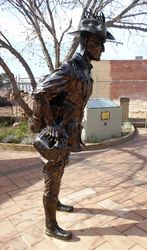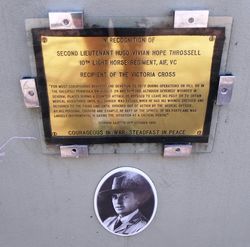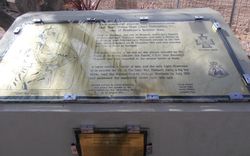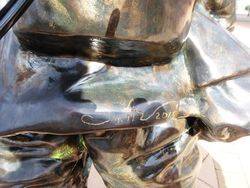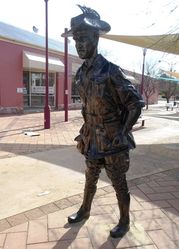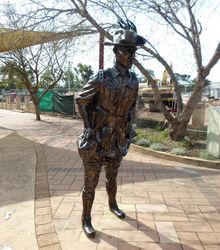
Captain Hugo Throssell V.C.Print Page 
The memorial, unveiled in 1999, commemorates Hugo Throssell who was awarded the Victoria Cross during World War One. On the 25th April 2015, a statue was unveiled at the site as part of the centenary of ANZAC.
Hugo Throssell came from a farming family in the Northam area. On 29 August 1915 the 10th Light Horse was brought into action to take a long trench, of which 100 yards was held by Turkish troops on the summit of Hill 60 at Gallipoli. As a guard, Throssell killed five Turks while his men constructed a barricade across their part of the trench. When a fierce bomb fight began, Throssell and his soldiers held their bombs on short fuse until the last possible moment before hurling them at the enemy on the other side of the barricade.
Throssell, who at one stage was in sole command, was wounded twice. His face covered in blood from bomb splinters in his forehead, he repeatedly yelled encouragement to his men. For his part in the battle Hugo Throssell was awarded the Victoria Cross (V.C.). It was the first V.C. to be received by a Western Australian in the war.
Northam Remembers
Another lasting legacy of the day was the unveiling of a life-size bronze sculpture of Northam’s Victoria Cross winner, Hugo Vivian Hope Throssell.
The statue, located in the Avon Mall was created by artists Joan and Charlie Smith. Mr Smith said author John Hamilton’s book on Throssell, The Price of Valour, was the inspiration behind the sculpture’s design, in particular the cover image. “I based the sculpture on the front photo on the book,” Mr Smith said. “The sculpture expresses the ethos of the entire group and not just the individual because Hugo always believed in the principle of the human being.” Mr Smith said a major part of the sculpture was the principle of pushing forward, highlighting the forward lean Mr Throssell’s statue takes on. “Hugo pushed on through war, through adversity and right until the end – he never shirked,” Mr Smith said. “That’s what we tried to capture in this sculpture.”
Northam Shire president Steven Pollard thanked his councillors and staff for their effort in establishing a “significant monument”.
Special guests in attendance for the unveiling were Mr Throssel’s family Rohan, Mikael, Aston, Laure and Lisa Throssell. They were impressed with the outcome. “It’s just perfect,” Lisa Throssell said. “It’s such a good likeness and I’m very proud.”
Excerpt from Farm Weekly, 27 April 2015.
Location
| Address: | Fitzgerald Street East , Avon Mall, Northam, 6401 |
|---|---|
| State: | WA |
| Area: | AUS |
| GPS Coordinates: | Lat: -31.653491 Long: 116.671468 Note: GPS Coordinates are approximate. |
Details
| Monument Type: | Monument |
|---|---|
| Monument Theme: | People |
| Sub-Theme: | Military |
| Artist: | Joan Walsh-Smith & Charles Smith (statue) |
| Link: | https://www.wikitree.com/wiki/Thros… |
Dedication
| Actual Monument Dedication Date: | Saturday 28th August, 1999 |
|---|
This memorial depicts and commemorates Capt. Hugo Vivian Hope (Jim) Throssell V.C., one of Northam's famous sons.
Born in Northam, the son of Western Australia`s second Premier, educated here and Adelaide, and later a farmer at Cowcowing near Wyalkatchem, Throssell enlisted in the 10th Light Horse Regiment on 19 December 1914 and was awarded the Victoria Cross at Gallipoli.
His medal citation is set out on the plaque donated by the Town of Northam (Mayor Jan Smith, C.E.O. Don Burnett).
Throssell was also wounded at the second Battle of Gaza.
A brave soldier, a leader of men and the only Light Horseman to be awarded the V.C. in the Great War, Throssell, riding a big bay horse, lead the Victory Parade through Northam in July 1919 and addressed the assembled crowd from this spot.
Funded entirely by public donations, this plaque was erected by the Hugo Throssell V.C. Memorial Fund on 28 August 1999.
Lloyd Nelson
David Sims
Jenny Hickey
Committee.
Plaque :
In recognition of Second Lieutenant Hugo Vivian Hope Throssell
10th Light Horse Regiment, AIF, VC
Recipient of the Victoria Cross
"For most conspicuous bravery and devotion to duty during operations on Hill 60 in the Gallipoli Peninsula on August 29 and 30th, 1915. Although severely wounded in several places during a counter attack, he refused to leave his post or to obtain medical assistance until all danger was passed, when he had his wounds dressed and returned to the firing line until ordered out of action by the Medical Officer.
By his personal courage and example, he kept up the spirits of his party, and was largely instrumental in saving the situation at a critical period.
(London Gazette : 15th October 1915)
Courageous in war : Steadfast in peace


